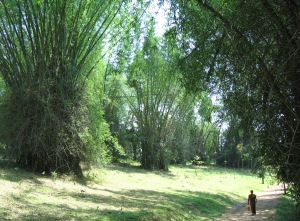Greening “One Belt – One Road” with bamboo and rattan
This morning, I attended the China Council for International Cooperation on Environment and Development (CCICED) Annual General Meeting for a discussion about the greening of the “One Belt One Road” initiative. President Xi Jinping launched the Silk Road Economic Belt and Maritime Silk Road in 2013, as two major regional cooperation efforts, and they are now referenced as the “One Belt One Road” initiative.
At the heart of “One Belt – One Road” lies the creation of an economic land belt that includes countries on the original Silk Road through Central Asia, West Asia, the Middle East and Europe, as well as a maritime road that links China’s port facilities with Southeast and South Asia and the African coast, pushing up through the Suez Canal into the Mediterranean. But it has developed into a major Regional development plan, and an opportunity to promote South-South cooperation amongst the 60+ countries involved.
Another Chinese innovation is the concept of eco-civilisation, which was incorporated into the Communist Party of China Charter at the 18th National Congress in 2012, indicating that it has been elevated to the center of China’s national development strategy. The core aim of eco-civilization is to balance the relationship between humanity and nature. Eco-civilisation is based on the socio-economic-environmental triangle of sustainable development, but also takes into account cultural and institutional considerations. I have talked about eco-civilization in previous reports about the Eco-Forum Global in Guiyang, Guizhou.
This CCICED meeting in Beijing brought together a group of experts to present their thoughts and recommendations about greening the “One Belt-One Road” initiative, and I was given the opportunity to speak about bamboo and rattan. I presented the International Network of Bamboo and Rattan (INBAR) as the first Inter-Governmental Organisation based in China and I explained how bamboo and rattan contribute to all 5 aspects of eco-civilisation.
- Economically, bamboo and rattan currently represent a market value of nearly USD 60 billion, with China as the dominant producer and Europe and USA as the two main consumers.
- Environmentally, bamboo and rattan provide opportunities for sustainable natural resources management, land restoration, climate change mitigation and biodiversity conservation. I reminded the audience that the Giant Panda depends on healthy bamboo vegetation for its survival.
- Socially, bamboo and rattan cultivation and small and medium enterprise development provides jobs and income for local poor communities. Some 7.5million people are engaged in bamboo industry in China and this is expected to rise to 10 million by 2020.
- Culturally, bamboo and rattan have been used for construction and production of furniture and household utensils for thousands of years, while bamboo is a traditional source of household energy. Both plants feature in local village life and play an important role in many traditions and ceremonies.
- Institutionally, bamboo development requires inter-sector coordination, as the plants and their products fall under the purview of several authorities, including those responsible for forestry, agriculture, environment, rural development, energy and small scale industries.
I reminded the audience that bamboo and rattan grow in many of the countries covered by the “One Belt One Road” initiative, and I made the point that bamboo and rattan therefore are excellent opportunities to promote green development in these countries. I explained that China is already providing training and capacity building for bamboo entrepreneurs, and promoting South-South collaboration in the field of bamboo and rattan development, bilaterally and through INBAR.
There is progress, and there are positive signs for global bamboo and rattan innovation and development. But – with proper planning and increased coordination, we can do a lot more!



